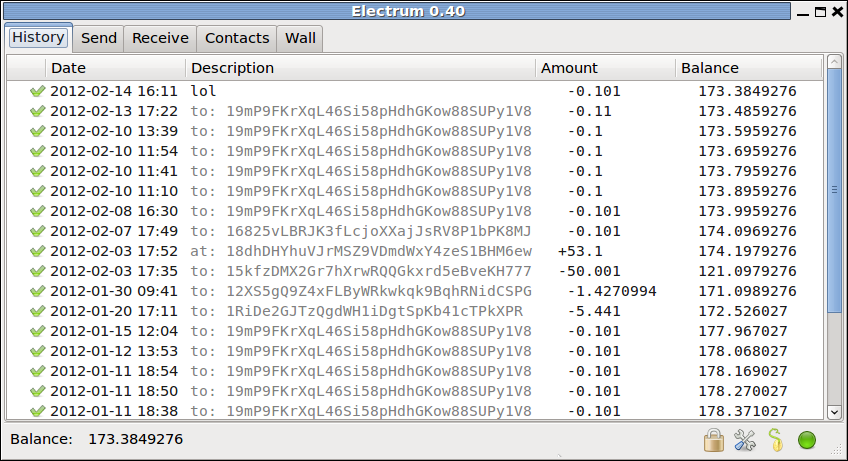Electrum

Electrum is a lightweight Bitcoin client, based on a client-server protocol. It was released on november 5, 2011.
Main features:
- Encrypted wallet: the file that contains your bitcoins is protected with a password. You are protected from thieves.
- Deterministic key generation: If you lose your wallet, you can recover it from its seed. You are protected from your own mistakes.
- Instant on: the client does not download the blockchain, it requests that information from a server. No delays, always up-to-date.
- Transactions are signed locally: Your private keys are not shared with the server. You do not have to trust the server with your money.
- Freedom and Privacy: The server does not store user accounts. You are not tied to a particular server, and the server does not need to know you.
- No scripts: Electrum does not download any script. A compromised server cannot send you arbitrary code and steal your bitcoins.
- No single point of failure: The server code is open source, anyone can run a server.
- Firewall friendly: The client does not need to open a port, it simply polls the server for updates.
- Free software: Gnu GPL v3. Anyone can audit the code.
- Written in Python. The code is short, and easy to review.
- Support for Bitcoin URIs, signed URIs and Bitcoin aliases
Graphical User Interfaces
Electrum has two GUIs: one that is based on Gtk, and a newer one based on Qt. The Qt GUI is enabled by default. To use the gtk interface, type:
$ ./electrum -g gtk
In addition, Electrum has a rich set of commands for the command line interface.
Brain Wallet
Electrum uses a type 2 deterministic key generation algorithm. This means that all the keys are derived from a seed.
Typical seeds have 128 bits of entropy. Electrum provides mnemonic code in order to represent the seed.
Example:
- hexadecimal: 431a62f1c86555d3c45e5c4d9e10c8c7
- mnemonic: "constant forest adore false green weave stop guy fur freeze giggle clock"
You can display the seed with the command line interface. Example:
$ ./electrum seed Password: 431a62f1c86555d3c45e5c4d9e10c8c7 "constant forest adore false green weave stop guy fur freeze giggle clock"
Multiple wallets
Electrum uses one single file per wallet. Your default wallet is located in your user account. If you want to use another wallet, use the -w option followed by the wallet path and name:
$ ./electrum -w /path/to/my/wallet/wallet_name
Export and import addresses
You can export your private keys using the 'addresses' command:
$ ./electrum addresses -ak Password: 1LGoehbyeX4QBEPK1a6dhyaoMQZfqg5LKX:5JBSttEGhjEcPidSovW66Rin2EZ6LEHZ2qx8Pu2RqqNaDTBVWaF 1KcsBJa2cCxVkGJfSsg5bUeXN7Y5uLa8mP:5KiP4uiNT6KG8jnXbainCM8rDWRrgxt3PAyut4FFpDoCo1Rh6VM 1PXsn7LVXTccGhJPTUL8r2EGB4fF9kvex3:5Kj8mvBJReyk8xEBMx5cTnciQCxto5JmudiTPkqwMcd61Kf1Jqc 1KteSFTAphyByLTtUfFiVQ9s7fMVmx7c2h:5JeZ3FTbWcksLt3PKydd5U9p952UQRHwv3LoxzCA9LZ7V2bku5p 1GE5ZChAobeTEPLHDCDDKTSg3XvLkcQFjS:5JwtGEygTwF2nouhRVzW3w5DWZd1sCgxLtnd1v51wjkbUrp5sqH 12YNehfAoYTiwjTXULwaZqTCauu2D61fq6:5Jvcq19ePCXKcVun4n7US99CsrEByUK2kgxXBA3rBVBqYZjhfwD [change]
There are two options in this example:
- option -a means: 'list all addresses'. if you don't use it, change addresses are not listed.
- option -k means: display the private keys
You can also import addresses into an electrum wallet, with the 'import' command:
$ ./electrum import 1LGoehbyeX4QBEPK1a6dhyaoMQZfqg5LKX:5JBSttEGhjEcPidSovW66Rin2EZ6LEHZ2qx8Pu2RqqNaDTBVWaF keypair imported
Note that imported keys do not belong to the deterministic sequence of your wallet; if you import keys in a wallet, you must back it up!
Offline wallet
It is possible to create a transaction on an offline computer, and to broadcast them from another computer, with a wallet that does not have the seed or private keys.
How to prepare an offline wallet
- step 1: create a wallet on your offline computer
[offline]$ electrum -o -w wallet create
- step 2: extract the seed from your wallet file:
[offline]$ electrum -o -w wallet deseed
This will remove the seed from 'wallet', and save it to a file named 'wallet.seed'
- step 3: transfer the deseeded wallet to the online computer (for example with a usb stick)
- step 4: run electrum on the online computer; this will synchronize your wallet with the bitcoin network, and you will be able to monitor incoming transactions:
[online]$ electrum -w wallet
How to send a transaction with an offline wallet
- step 1: copy the synchronized wallet file to your offline computer, in the directory where the seed is.
- step 2: restore the seed in the wallet file:
[offline]$ electrum -w wallet reseed
- step 3: create the transaction
[offline]$ electrum -w wallet mktx <recipient> <amount> > tx_file
- step 4: with the usb stick, copy the transaction to the online computer:
- step 5: broadcast the transaction on the online computer:
[online]$ electrum -w wallet sendtx `cat tx_file`
List of commands
| command | description | syntax | requires password | needs to be online |
|---|---|---|---|---|
| addresses | show your list of addresses, optionally with private keys. | addresses [-a] [-b] [-k] | iff -k | no |
| balance | shows the balance of your wallet or of an address | balance [address] | no | yes |
| contacts | print your list of contacts | contacts | no | no |
| create | create a new wallet | create | no | no |
| deseed | Remove seed from wallet and store it to .seed file | deseed | no | no |
| eval | call python eval | eval <expression> | no | no |
| help | display the help for a command | help [command] | no | no |
| history | print the transaction history | history | no | yes |
| import | import a keypair | import <address:private_key> | yes | no |
| label | change the label of a transaction or address | label <label> | no | no |
| mktx | create a transaction and dump it | mktx [-s sourceaddr] [-c changeaddr] [-f fee] <address> <amount> | yes | no |
| password | update your password | password | yes | no |
| payto | create and broadcast a transaction | payto [-s sourceaddr] [-c changeaddr] [-f fee] <address> <amount> | yes | yes |
| reseed | take seed from .seed file and add it to wallet (it checks that keys are consistent). | reseed | no | no |
| restore | restore a wallet from seed | restore | no | yes |
| sendtx | broadcast a transaction | sendtx <tx> | no | yes |
| seed | print your seed | seed | yes | no |
| signmessage | sign a message (as in bitcoind) | signmessage <address> <message> | yes | no |
| validateaddress | check is the argument is a valid bitcoin address | validateaddress <address> | no | no |
| verifymessage | verify a message (as in bitcoind) | verifymessage <address> <signature> <message> | no | no |
History
Electrum was announced November 5, 2011[1].
See Also
- Electrum/Documentation : General documentation of the Electrum client
- Electrum/Translation
- Electrum/TODO
- Thin Client Security
